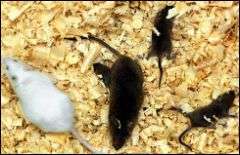Researchers compare mammals' genomes to aid human clinical research

For years, scientists have considered the laboratory mouse one of the best models for researching disease in humans because of the genetic similarity between the two mammals. Now, researchers at the Stanford University School of Medicine have found that the basic principles of how genes are controlled are similar in the two species, validating the mouse's utility in clinical research.
However, there are important differences in the details of gene regulation that distinguish us as a species.
"At the end of the day, a lot of the genes are identical between a mouse and a human, but we would argue how they're regulated is quite different," said Michael Snyder, PhD, professor and chair of genetics at Stanford. "We are interested in what makes a mouse a mouse and a human a human."
The research effort, Mouse ENCODE, is meant to complement a project called the Encyclopedia of DNA Elements, or ENCODE, that began in 2003. ENCODE studied specific components in the human genome that guide genes to code for proteins that carry out a cell's function, a process known as gene expression. Surrounding the protein-coding genes are noncoding regulatory elements, molecules that regulate gene expression by attaching proteins, called transcription factors, to specific regions of DNA.
Why mice matter
Mouse ENCODE analyzed more than 100 mouse cell types and tissues to annotate the regulatory elements of the mouse genome and compare them to the regulatory elements in the human genome. Both ENCODE and Mouse ENCODE are funded and coordinated by the National Human Genome Research Institute. Because mice are used as model organisms for many human clinical studies and drug discovery, understanding the similarities and differences can help researchers understand how the results found in mouse studies can translate to humans.
"The mindset is when you compare things, it helps understand genome annotation," said Mark Gerstein, PhD, the Albert L. Williams Professor of Biomedical Informatics at Yale University. "It's making the mouse a more meaningful model organism." Gerstein collaborated on previous ENCODE research but is not part of the Mouse ENCODE consortium, which is composed of researchers from more than 30 institutions.
Snyder is a co-senior author of the main paper—which will be published in Nature on Nov. 19—that describes the overall findings of the project, and of two companion papers (one to be published in the same issue of Nature, the other to be published online Nov. 17 in the Proceedings of the National Academy of Sciences) that explain individual components of the project.
Stanford postdoctoral scholars Yong Cheng, PhD, and Zhihai Ma, PhD, are co-lead authors of the Nature companion paper. They compared where 34 transcription factors attach to the DNA strand to control gene expression on regions called binding sites.
Details differ
"Transcription factors are kind of like people: They work together in many different combinations to execute certain tasks," said Snyder, who holds the Stanford W. Ascherman, MD, FACS Professorship in Genetics. "What we discovered is that the general principles are the same in mice and people, but the details are quite different. In general, the mouse factors are binding at different locations than the human ones in terms of the exact gene targets."
The researchers' abundant data is a valuable resource for others studying disease-related genes in mice. They can use the Mouse ENCODE data to see whether the transcription factors regulating their studies' gene expression are the same or different for humans.
"If you focus on a gene that is similar to humans, the result should be easier to transfer from mouse to human," said Cheng. "But if you're working on a gene that is different, you need to pay more attention to whether this result can be successfully applied to the human subjects."
Shin Lin, MD, PhD, MHS, postdoctoral scholar and clinical instructor in cardiovascular medicine, was co-lead author of a companion paper published in the Proceedings of the National Academy of Sciences along with Yiing Lin, MD, PhD. The study compared gene expression profiles across 15 tissues types in humans and mice.
They found that gene expression profiles in mouse tissues are more similar to one another than to their human counterparts. In other words, in terms of the way genes are expressed, a mouse liver is more similar to a mouse kidney than to a human liver, Snyder said.
Understanding the fundamentals
"The mouse is the premier organism for modeling human disease and many other things—a lot of what we know about human biology does come from the mouse," Snyder said. "The genome is what controls everything at some level. We're interested in trying to understand the basic processes about how they're similar or different across some of the most important species people are studying. It's just fundamentally important."
More information: A comparative encyclopedia of DNA elements in the mouse genome, DOI: 10.1038/nature13992
Conservation of trans-acting circuitry during mammalian regulatory evolution, DOI: 10.1038/nature13972
Principles of regulatory information conservation between mouse and human, DOI: 10.1038/nature13985
Topologically associating domains are stable units of replication-timing regulation, DOI: 10.1038/nature13986
Journal information: Nature , Proceedings of the National Academy of Sciences
Provided by Stanford University Medical Center



















